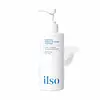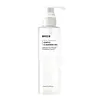What's inside
What's inside
 Key Ingredients
Key Ingredients

 Benefits
Benefits

 Concerns
Concerns

 Ingredients Side-by-side
Ingredients Side-by-side

Water
Skin ConditioningGlycerin
HumectantMethyl Perfluoroisobutyl Ether
SolventDecyl Glucoside
CleansingPotassium Cocoyl Glycinate
Disodium Cocoamphodiacetate
CleansingAcrylates Copolymer
Babassuamidopropyl Betaine
CleansingSodium Methyl Cocoyl Taurate
CleansingSodium Chloride
MaskingCaprylyl Glycol
EmollientPolyester-11
Skin ConditioningEthylhexylglycerin
Skin ConditioningGlycine Soja Protein
EmulsifyingSqualane
EmollientCentella Asiatica Extract
CleansingButylene Glycol
HumectantPropanediol
Solvent1,2-Hexanediol
Skin ConditioningHexylene Glycol
EmulsifyingPalmitoyl Glycine
CleansingDipropylene Glycol
HumectantSodium Palmitoyl Proline
Skin ConditioningVitis Vinifera Fruit Extract
Skin ConditioningCarica Papaya Fruit Extract
Skin ConditioningPrunus Mume Fruit Extract
HumectantMalus Domestica Fruit Extract
AntioxidantCeramide NP
Skin ConditioningEctoin
Skin ConditioningGinkgo Biloba Leaf Extract
Skin ConditioningNymphaea Alba Flower Extract
Skin ConditioningSpirulina Platensis Extract
Skin ProtectingAloe Barbadensis Leaf Juice
Skin ConditioningHouttuynia Cordata Extract
Skin ConditioningLactobacillus Ferment
Skin ConditioningSodium Hyaluronate Crosspolymer
HumectantStellaria Media Extract
Skin ConditioningCamellia Sinensis Leaf Extract
AntimicrobialCastanea Crenata Shell Extract
Skin ConditioningDiospyros Kaki Fruit Extract
Skin ConditioningGlycine
BufferingCaprylic/Capric Triglyceride
MaskingHydrolyzed Glycosaminoglycans
HumectantSerine
MaskingGlutamic Acid
HumectantSodium Hyaluronate
HumectantAspartic Acid
MaskingLeucine
Skin ConditioningHydrogenated Lecithin
EmulsifyingTheanine
EmollientAlanine
MaskingLysine
Skin ConditioningMilk Lipids
Skin ConditioningArginine
MaskingTyrosine
MaskingPhenylalanine
MaskingBenzyl Glycol
SolventProline
Skin ConditioningThreonine
Valine
MaskingIsoleucine
Skin ConditioningGlutathione
Hydrolyzed Hyaluronic Acid
HumectantHistidine
HumectantCysteine
AntioxidantMethionine
Skin ConditioningAllantoin
Skin ConditioningMacadamia Ternifolia Seed Oil
EmollientPanthenol
Skin ConditioningAsiatic Acid
Skin ConditioningAsiaticoside
AntioxidantBrassica Campestris Sterols
EmollientCholesterol
EmollientDipotassium Glycyrrhizate
HumectantMadecassic Acid
Skin ConditioningMadecassoside
AntioxidantHyaluronic Acid
HumectantRaspberry Ketone
MaskingWater, Glycerin, Methyl Perfluoroisobutyl Ether, Decyl Glucoside, Potassium Cocoyl Glycinate, Disodium Cocoamphodiacetate, Acrylates Copolymer, Babassuamidopropyl Betaine, Sodium Methyl Cocoyl Taurate, Sodium Chloride, Caprylyl Glycol, Polyester-11, Ethylhexylglycerin, Glycine Soja Protein, Squalane, Centella Asiatica Extract, Butylene Glycol, Propanediol, 1,2-Hexanediol, Hexylene Glycol, Palmitoyl Glycine, Dipropylene Glycol, Sodium Palmitoyl Proline, Vitis Vinifera Fruit Extract, Carica Papaya Fruit Extract, Prunus Mume Fruit Extract, Malus Domestica Fruit Extract, Ceramide NP, Ectoin, Ginkgo Biloba Leaf Extract, Nymphaea Alba Flower Extract, Spirulina Platensis Extract, Aloe Barbadensis Leaf Juice, Houttuynia Cordata Extract, Lactobacillus Ferment, Sodium Hyaluronate Crosspolymer, Stellaria Media Extract, Camellia Sinensis Leaf Extract, Castanea Crenata Shell Extract, Diospyros Kaki Fruit Extract, Glycine, Caprylic/Capric Triglyceride, Hydrolyzed Glycosaminoglycans, Serine, Glutamic Acid, Sodium Hyaluronate, Aspartic Acid, Leucine, Hydrogenated Lecithin, Theanine, Alanine, Lysine, Milk Lipids, Arginine, Tyrosine, Phenylalanine, Benzyl Glycol, Proline, Threonine, Valine, Isoleucine, Glutathione, Hydrolyzed Hyaluronic Acid, Histidine, Cysteine, Methionine, Allantoin, Macadamia Ternifolia Seed Oil, Panthenol, Asiatic Acid, Asiaticoside, Brassica Campestris Sterols, Cholesterol, Dipotassium Glycyrrhizate, Madecassic Acid, Madecassoside, Hyaluronic Acid, Raspberry Ketone
Water
Skin ConditioningGlycerin
HumectantSodium Cocoyl Alaninate
Lauryl Hydroxysultaine
CleansingLauryl Glucoside
CleansingQuillaja Saponaria Bark Extract
CleansingSodium Hyaluronate
HumectantHydrolyzed Hyaluronic Acid
HumectantHyaluronic Acid
HumectantAcrylates/C10-30 Alkyl Acrylate Crosspolymer
Emulsion StabilisingCoco-Betaine
Cleansing1,2-Hexanediol
Skin ConditioningCaprylyl Glycol
EmollientCoco-Glucoside
CleansingSodium Cocoyl Isethionate
CleansingSodium Myristoyl Glutamate
CleansingProtease
ExfoliatingButylene Glycol
HumectantPropanediol
SolventBenzyl Glycol
SolventHydrolyzed Glycosaminoglycans
HumectantSodium Hyaluronate Crosspolymer
HumectantEthylhexylglycerin
Skin ConditioningHydroxypropyltrimonium Hyaluronate
Sodium Acetylated Hyaluronate
HumectantCitric Acid
BufferingSodium Chloride
MaskingWater, Glycerin, Sodium Cocoyl Alaninate, Lauryl Hydroxysultaine, Lauryl Glucoside, Quillaja Saponaria Bark Extract, Sodium Hyaluronate, Hydrolyzed Hyaluronic Acid, Hyaluronic Acid, Acrylates/C10-30 Alkyl Acrylate Crosspolymer, Coco-Betaine, 1,2-Hexanediol, Caprylyl Glycol, Coco-Glucoside, Sodium Cocoyl Isethionate, Sodium Myristoyl Glutamate, Protease, Butylene Glycol, Propanediol, Benzyl Glycol, Hydrolyzed Glycosaminoglycans, Sodium Hyaluronate Crosspolymer, Ethylhexylglycerin, Hydroxypropyltrimonium Hyaluronate, Sodium Acetylated Hyaluronate, Citric Acid, Sodium Chloride
 Reviews
Reviews

Ingredients Explained
These ingredients are found in both products.
Ingredients higher up in an ingredient list are typically present in a larger amount.
1,2-Hexanediol is a synthetic liquid and another multi-functional powerhouse.
It is a:
- Humectant, drawing moisture into the skin
- Emollient, helping to soften skin
- Solvent, dispersing and stabilizing formulas
- Preservative booster, enhancing the antimicrobial activity of other preservatives
We don't have a description for Benzyl Glycol yet.
Butylene Glycol (or BG) is used within cosmetic products for a few different reasons:
Overall, Butylene Glycol is a safe and well-rounded ingredient that works well with other ingredients.
Though this ingredient works well with most skin types, some people with sensitive skin may experience a reaction such as allergic rashes, closed comedones, or itchiness.
Learn more about Butylene GlycolCaprylyl Glycol is a humectant and emollient, meaning it attracts and preserves moisture.
It is a common ingredient in many products, especially those designed to hydrate skin. The primary benefits are retaining moisture, skin softening, and promoting a healthy skin barrier.
Though Caprylyl Glycol is an alcohol derived from fatty acids, it is not the kind that can dry out skin.
This ingredient is also used as a preservative to extend the life of products. It has slight antimicrobial properties.
Learn more about Caprylyl GlycolEthylhexylglycerin (we can't pronounce this either) is commonly used as a preservative and skin softener. It is derived from glyceryl.
You might see Ethylhexylglycerin often paired with other preservatives such as phenoxyethanol. Ethylhexylglycerin has been found to increase the effectiveness of these other preservatives.
Glycerin is already naturally found in your skin. It helps moisturize and protect your skin.
A study from 2016 found glycerin to be more effective as a humectant than AHAs and hyaluronic acid.
As a humectant, it helps the skin stay hydrated by pulling moisture to your skin. The low molecular weight of glycerin allows it to pull moisture into the deeper layers of your skin.
Hydrated skin improves your skin barrier; Your skin barrier helps protect against irritants and bacteria.
Glycerin has also been found to have antimicrobial and antiviral properties. Due to these properties, glycerin is often used in wound and burn treatments.
In cosmetics, glycerin is usually derived from plants such as soybean or palm. However, it can also be sourced from animals, such as tallow or animal fat.
This ingredient is organic, colorless, odorless, and non-toxic.
Glycerin is the name for this ingredient in American English. British English uses Glycerol/Glycerine.
Learn more about GlycerinHyaluronic acid is naturally found in healthy skin. It is a humectant, meaning it draws moisture to your skin.
This ingredient helps hydrate, soothe, and protect the skin.
What makes hyaluronic acid so hydrating? It has the capacity to bind or hold large amounts of water.
Fun fact: It is already naturally found in our bodies, such as the fluids of our eyes and our joints.
Studies find this ingredient to have anti-inflammatory and anti-microbial properties. This can help speed up wound-healing.
Hyaluronic acid can be irritating if the molecule has a low-molecular weight, or if the molecules are small.
One study found low-molecular weight hyaluronic acid to be pro-inflammatory, meaning some people may experience irritation. This is because our bodies use hyaluronic acid in the wound-healing process to signal to our bodies, via irritation, that something needs healing.
The same study found high-molecular weight hyaluronic acid to be anti-inflammatory.
These are some other common types of Hyaluronic Acid:
Learn more about Hyaluronic AcidWe don't have a description for Hydrolyzed Glycosaminoglycans yet.
Hydrolyzed Hyaluronic Acid is a form of hyaluronic acid. It is created by the hydrolysis of hyaluronic acid with a high molecular weight. Once created, Hydrolyzed Hyaluronic Acid has a low molecular weight.
Low molecular weight HA has been shown to hydrate and increase elasticity of the skin. Increasing elasticity is also associated with reduction of wrinkle depth.
One study found topical low molecular weight hyaluronic acid may be considered for the treatment of rosacea in the adult population. However, we always recommend speaking with a professional about your skin concerns.
Hyaluronic acids are a humectant. This means they draw moisture from the air. Hyaluronic acids help moisturize, soothe, and protect the skin.
Read more about other common forms of hyaluronic acid:
Learn more about Hydrolyzed Hyaluronic AcidPropanediol is an all-star ingredient. It softens, hydrates, and smooths the skin.
It’s often used to:
Propanediol is not likely to cause sensitivity and considered safe to use. It is derived from corn or petroleum with a clear color and no scent.
Learn more about PropanediolChances are, you eat sodium chloride every day. Sodium Chloride is also known as table salt.
This ingredient has many purposes in skincare: thickener, emulsifier, and exfoliator.
You'll most likely find this ingredient in cleansers where it is used to create a gel-like texture. As an emulsifier, it also prevents ingredients from separating.
There is much debate on whether this ingredient is comedogenic. The short answer - comedogenic ratings don't tell the whole story. Learn more about comegodenic ratings here.
The concensus about this ingredient causing acne seems to be divided. Research is needed to understand if this ingredient does cause acne.
Scrubs may use salt as the primary exfoliating ingredient.
Learn more about Sodium ChlorideSodium Hyaluronate is hyaluronic acid's salt form. It is commonly derived from the sodium salt of hyaluronic acid.
Like hyaluronic acid, it is great at holding water and acts as a humectant. This makes it a great skin hydrating ingredient.
Sodium Hyaluronate is naturally occurring in our bodies and is mostly found in eye fluid and joints.
These are some other common types of Hyaluronic Acid:
Learn more about Sodium HyaluronateSodium Hyaluronate Crosspolymer is a type of hyaluronic acid. In fact, it is modified version of hyaluronic acid.
The structure of Sodium Hyaluronate Crosspolymer allows it to stay in the skin's top layer for a longer period of time. This allows for even more hydration and humectant action than hyaluronic acid.
These are some other common types of Hyaluronic Acid:
Learn more about Sodium Hyaluronate CrosspolymerWater. It's the most common cosmetic ingredient of all. You'll usually see it at the top of ingredient lists, meaning that it makes up the largest part of the product.
So why is it so popular? Water most often acts as a solvent - this means that it helps dissolve other ingredients into the formulation.
You'll also recognize water as that liquid we all need to stay alive. If you see this, drink a glass of water. Stay hydrated!
Learn more about Water